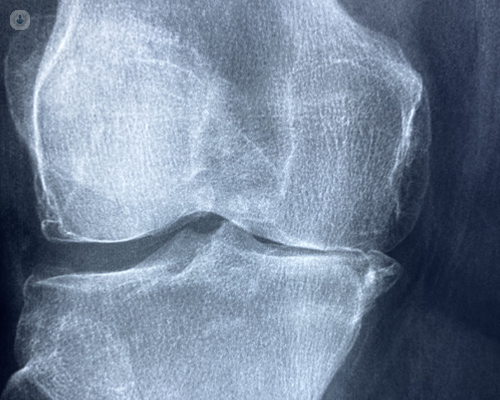Knee pain and its causes
Escrito por:Leading consultant orthopaedic hip and knee surgeon Mr Amit Kotecha explores the various causes of knee pain and how they can be diagnosed and managed.

Can knee pain be caused by anything other than injuries or overuse?
Yes, knee pain can result from a variety of factors besides injuries or overuse. These may include degenerative conditions such as osteoarthritis, or inflammatory conditions like:
- rheumatoid arthritis;
- infections;
- gout;
- bursitis;
- tendonitis;
- meniscus tears (cushion cartilage in the knee);
- ligament injuries (such as ACL or PCL tears);
- patellofemoral pain syndrome;
- and occasionally, the pain can be referred from hip problems to the knee.
How can the location of knee pain offer clues to the underlying cause?
The location of knee pain can provide valuable information about the underlying cause. For example:
- Pain at the front of the knee may be indicative of patellofemoral pain syndrome, patellar tendonitis, or chondromalacia patellae or patellofemoral arthritis
- Pain on the inner side of the knee may suggest a medial meniscus tear, MCL injury, or osteoarthritis.
- Pain on the outer side of the knee may be associated with a lateral meniscus tear, IT band syndrome, or iliotibial band friction syndrome.
- Pain at the back of the knee may be related to a Baker's cyst, popliteal tendonitis, or hamstring tendonitis.
Do the most common causes of knee pain differ depending on age?
The causes of knee pain can vary depending on age. In younger individuals, knee pain is often related to sports injuries, ligament tears, meniscus tears, or overuse.
In teenagers’ pain can be due to inflammation of patellar tendon attachment onto the shin (Osgood Schlatter’s disease).
As people age, the prevalence of degenerative conditions such as osteoarthritis increases, leading to knee pain and stiffness. Inflammatory conditions such as rheumatoid arthritis may also become more common with age.
Can weak or imbalanced muscles contribute to knee pain, and if so, how?
Yes, weak or imbalanced muscles around the knee joint can contribute to knee pain. The muscles surrounding the knee, including the quadriceps, hamstrings, and calf muscles, play a crucial role in providing stability and support to the joint. Weakness or imbalance in these muscles can lead to abnormal stress and strain on the knee joint, increasing the risk of injuries and pain.
Knee function is based on good muscle tone and balance in the quadriceps and hamstring muscles. Body weight going through the knee produces joint reaction forces. In case of weak muscles or imbalance muscles it can increase the forces and cause pain and discomfort. It can also lead to symptoms of instability.
This is why a healthy lifestyle with regular exercises and healthy diet is good for the joints.
Physical therapy and targeted exercises to strengthen and balance the muscles around the knee can help alleviate pain and improve function.
What diagnostic tools do doctors use to pinpoint the exact cause of knee pain?
Doctors may use a combination of clinical evaluation, imaging studies, and diagnostic tests to pinpoint the exact cause of knee pain. These may include:
- Physical examination to assess range of motion, stability, and signs of inflammation.
- X-rays to evaluate the bony structures of the knee joint.
- MRI or CT scans to assess soft tissue structures such as ligaments, tendons and cartilage.
- Ultrasound to evaluate for fluid accumulation or soft tissue abnormalities.
- Arthroscopy, a minimally invasive surgical procedure, to directly visualise and diagnose internal knee joint problems.
Knee pain can significantly impact daily activities and quality of life. By understanding the various causes of knee pain and how they are diagnosed and managed, patients can make informed decisions about their treatment options. If you’re experiencing knee pain, it’s essential to consult with a qualified orthopaedic specialist who can provide an accurate diagnosis and develop a personalised treatment plan that’s tailored to your needs.
If you require expert knee pain treatment that could require surgery, arrange a consultation with Mr Kotecha via his Top Doctors profile.


